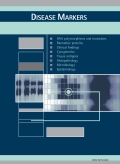Authors: El-Tayeh, Sarmad F. | Hussein, Tarek D. | El-Houseini, Motawa E. | Amer, Mahmoud A. | El-Sherbini, Mamdooh | Elshemey, Wael M.
Article Type:
Research Article
Abstract:
Hepatocellular carcinoma (HCC) is one of the most aggressive cancers worldwide. In Egypt, the disease is usually detected in an advanced stage at which no treatment may be effective including surgery. Early detection of the disease is thus an important goal allowing the patient to be treated before the enlargement of the tumor or its metastasis to distant organs. Tumor markers are serological agents which serum level may be useful in predicting the presence of the
…tumor at early stages. Alpha fetoprotein (AFP) which is the golden marker for HCC is of low sensitivity, therefore, additional markers such as alpha-L-fucosidase (AFU), transforming growth factors alpha and beta (TGF-α and TGF-β) and interleukin-8 (IL-8) are suggested to be simultaneously evaluated in order to enhance the detection of HCC. A total of 96 patients with different liver diseases such as HCC, hepatitis C virus (HCV), hepatitis B virus (HBV) and cirrhotic patients are included in this study. Sixteen healthy volunteers are used as a control group. In patients with HCC each of AFP, AFU, TGF-α and TGF-β recorded significantly higher levels than the other patient groups and controls. HCC patients recorded significantly lower level of IL-8 compared to the other patient groups but significantly higher than the control. For AFP, AFU, TGF-α, TGF-β and IL-8, at the optimal cut-off values (obtained from the receiver operating characteristic (ROC) curves), the calculated sensitivities are 46%, 72.97%, 67.56%, 54.05% and 83.8%, respectively. The simultaneous evaluation using all of the suggested markers resulted in increasing the sensitivity up to 100%. It thus recommended that, if patients with cirrhosis, as high risk patients, are subjected to regular examination using these markers in addition to AFP, HCC may be detected by 100% sensitivity in an early stage and as a consequence an effective treatment can be achieved.
Show more
Keywords: AFP, AFU, TGF-α, TGF-β, IL-8, HCC, HCV, biomarkers
DOI: 10.3233/DMA-2011-0883
Citation: Disease Markers,
vol. 32, no. 4, pp. 255-263, 2012
Price: EUR 27.50





